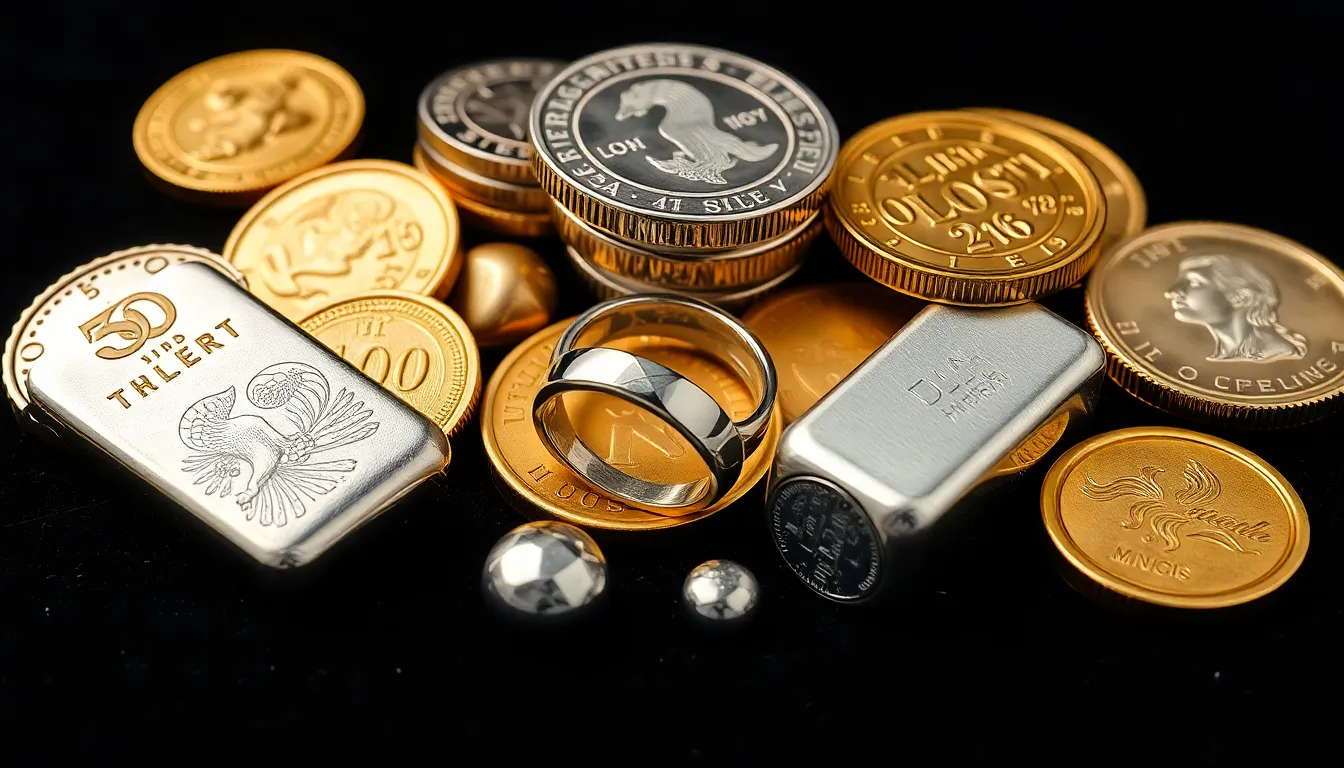In a world where everything seems to lose value faster than a smartphone’s battery, precious metals stand tall as the shiny guardians of wealth. Gold, silver, and platinum aren’t just for pirates and kings anymore; they’re the savvy investor’s best friends. Imagine having a treasure chest filled with glittering assets that can weather economic storms and make your portfolio sparkle.
But what’s the deal with these metals? Are they just shiny rocks or do they hold real value? As it turns out, these gleaming beauties are more than just eye candy; they’re crucial players in the global economy. Whether you’re a seasoned investor or just dipping your toes in the market, understanding precious metals can turn you into a financial wizard—or at least help you impress your friends at dinner parties. Let’s dive into the fascinating world of precious metals and discover why they deserve a spot in your investment strategy.
Table of Contents
ToggleOverview of Precious Metals
Precious metals are rare and valuable resources known for their significant role in global economies. Gold, silver, and platinum are the primary metals that attract attention from investors and collectors alike. These metals not only possess intrinsic worth but also serve practical purposes in various industries.
Gold stands out for its historical importance as a currency and its function as a safe-haven asset during economic uncertainties. Many investors turn to gold to hedge against inflation and currency fluctuations. Governments and central banks also hold substantial gold reserves to bolster national wealth.
Silver offers unique properties, making it indispensable in electronics, batteries, and solar panels. Industrial demand for silver enhances its value beyond investment perspectives. The metal’s affordability compared to gold allows more individuals to incorporate it into their portfolios.
Platinum holds a reputation for rarity, often found in lower quantities than gold or silver. Though primarily used in automotive catalysis and jewelry, platinum’s market fluctuates based on industrial demand and economic conditions. Investors often perceive platinum as a long-term investment due to its potential for value appreciation.
Collectively, precious metals serve as an effective diversification tool in financial strategies. Holding a mix of these metals can stabilize an investor’s portfolio against volatility in traditional markets. Understanding each metal’s unique characteristics enables individuals to make informed decisions about their investments.
Types of Precious Metals

Different types of precious metals serve various purposes in investment and industry. Each metal holds unique characteristics that contribute to its value and demand.
Gold
Gold remains the most recognized precious metal. Historically, it served as currency and continues to be a safe-haven asset during economic downturns. Investors often turn to gold to hedge against inflation and currency devaluation. Its universal appeal and established value make it a preferred choice for both new and experienced investors. Jewelry production and electronic components utilize gold, further driving its demand. Market fluctuations often influence its price, yet gold typically maintains its status as a trustworthy investment.
Silver
Silver stands out for its industrial applications and affordability. While it also serves as a form of investment, its uses in electronics, solar panels, and medical equipment are significant. Investors appreciate silver for its lower entry cost compared to gold, allowing broader access. Demand from industries ensures silver’s continued relevance in the market. Fluctuations in supply and demand impact its value, but its historical significance as a monetary asset solidifies its worth as a long-term investment.
Platinum
Platinum ranks among the rarest precious metals, which contributes to its high value. It plays a crucial role in the automotive industry, particularly in catalytic converters, helping reduce harmful emissions. Jewelry also utilizes platinum, appealing to luxury markets due to its durability and luster. Lessened production due to mining challenges often creates price instability. Investors seeking diversification benefit from incorporating platinum into their portfolios, especially due to its industrial demand.
Palladium
Palladium has gained popularity as a precious metal with strong industrial demand. Primarily used in automotive manufacturing, it helps reduce pollutants in exhaust systems. Recent years have seen a surge in its market price due to supply shortages and increased environmental regulations. Investors view palladium as a viable alternative to platinum, with similar industrial uses. Its growing importance in technology and renewable energy sectors reinforces its value as an investment.
Investment Potential of Precious Metals
Precious metals offer substantial investment potential due to their intrinsic value and historical stability. Investors often regard these commodities as safe havens amid market fluctuations.
Historical Performance
Gold has maintained a prominent position as a reliable store of value, especially during economic downturns. The metal consistently shows resilience, increasing in value during market crises. Historical data indicates that gold’s price surged from approximately $300 per ounce in early 2000 to over $1,800 per ounce by 2021. Silver, too, showcased substantial returns over decades, with a marked price increase from about $4 per ounce in 2000 to nearly $27 per ounce in 2021. Platinum’s price has fluctuated but reached peaks of around $2,000 per ounce, highlighting its volatility. Collectively, these metals have proven their capacity to be effective long-term investments.
Market Trends
Current market trends exhibit fluctuating demand driven by both industrial applications and investment interest. Increasing economic uncertainties have heightened gold demand, creating upward pressure on prices. Silver’s affordability leads many new investors to explore its potential during bullish market phases. Recently, palladium prices rose sharply due to automotive industry demand and environmental regulations. Platinum, often lagging behind, is starting to gain traction as a result of its essential role in catalysts. Shifts in consumer behavior indicate a growing interest in sustainable investments, favoring metals with strong industrial uses.
Industrial Usage of Precious Metals
Precious metals play a vital role in various industries, showcasing their versatility beyond just investment opportunities.
Electronics
Gold conducts electricity exceptionally well, making it a preferred choice for electronic components. Manufacturers incorporate gold in connectors, switches, and integrated circuits due to its reliability and durability. Silver, with its highest electrical conductivity, finds extensive applications in electrical contacts and circuit boards. Electronics reliant on precious metals benefit from improved performance and longevity. Increasing demand for consumer electronics drives the use of these metals, creating a significant market for manufacturers. Likewise, companies prioritize sustainability, often choosing precious metals for their environmental benefits.
Automotive
The automotive industry heavily relies on platinum and palladium for catalytic converters. These components reduce harmful emissions, ensuring compliance with environmental regulations. Demand for palladium has surged, driven by stricter emission standards globally. Many manufacturers pivot towards palladium, especially for gasoline engines. Platinum maintains importance in diesel engines, showcasing its catalytic properties. The shift towards electric vehicles may influence future demand, with manufacturers exploring various precious metals for innovative components. Sustained growth in automotive production directly correlates with the need for these metals.
Jewelry
Jewelry represents one of the most recognizable uses of precious metals, particularly gold and platinum. Consumers appreciate gold for its aesthetic appeal and status, thus driving high demand in jewelry fashion. Platinum, known for its rarity, attracts luxury buyers, often overshadowing traditional gold pieces. Silver, while more affordable, garners attention in artisan and custom jewelry designs. This blend of precious metals allows artisans to create unique, high-quality pieces. As trends evolve, precious metals remain central to the jewelry industry, reflecting individual expression and craftsmanship.
Precious metals remain a cornerstone of financial strategies and industrial applications. Their unique properties and historical significance make them invaluable assets in today’s economy. Investors are increasingly recognizing the importance of incorporating these metals into their portfolios to mitigate risks and enhance returns.
As market dynamics shift and industries evolve, the demand for gold, silver, platinum, and palladium is likely to grow. Understanding the nuances of each metal can empower individuals to make informed decisions and capitalize on opportunities. By embracing the potential of precious metals, investors can secure their financial futures while benefiting from their multifaceted roles in various sectors.


